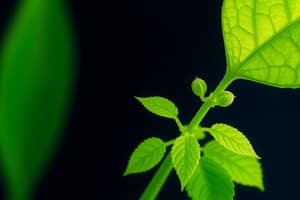Podcast
Questions and Answers
What is the first molecule that carbon dioxide is attached to in the Calvin Cycle?
What is the first molecule that carbon dioxide is attached to in the Calvin Cycle?
- RuBP (correct)
- BPG
- 3PG
- G3P
Which stage of the Calvin Cycle involves the transformation of 3PG into BPG?
Which stage of the Calvin Cycle involves the transformation of 3PG into BPG?
- Light Reactions
- Carbon Dioxide Reduction (correct)
- RuBP Regeneration
- Carbon Dioxide Fixation
How many G3P molecules are used to regenerate three RuBP during three turns of the Calvin Cycle?
How many G3P molecules are used to regenerate three RuBP during three turns of the Calvin Cycle?
- 6 G3P
- 9 G3P
- 5 G3P (correct)
- 3 G3P
Which energy molecules are utilized during the Carbon Dioxide Reduction phase of the Calvin Cycle?
Which energy molecules are utilized during the Carbon Dioxide Reduction phase of the Calvin Cycle?
What is the main product of the Calvin Cycle that can be further transformed into other organic molecules?
What is the main product of the Calvin Cycle that can be further transformed into other organic molecules?
What is the role of RuBP Carboxylase (Rubisco) in the Calvin Cycle?
What is the role of RuBP Carboxylase (Rubisco) in the Calvin Cycle?
Which statement about the Calvin Cycle is incorrect?
Which statement about the Calvin Cycle is incorrect?
Which product of the Calvin Cycle is a 3-carbon molecule that can contribute to various carbohydrate sources?
Which product of the Calvin Cycle is a 3-carbon molecule that can contribute to various carbohydrate sources?
What happens to CO2 and O2 levels in C3 plants when their stomata close in hot or dry conditions?
What happens to CO2 and O2 levels in C3 plants when their stomata close in hot or dry conditions?
Which enzyme do C4 plants use to initially fix CO2 in the 'pre-Calvin' cycle?
Which enzyme do C4 plants use to initially fix CO2 in the 'pre-Calvin' cycle?
Why are C4 plants more productive than C3 plants in hot and dry climates?
Why are C4 plants more productive than C3 plants in hot and dry climates?
What is the primary characteristic of CAM photosynthesis?
What is the primary characteristic of CAM photosynthesis?
In what type of environments do C4 plants compete poorly with C3 plants?
In what type of environments do C4 plants compete poorly with C3 plants?
What consequence does photorespiration have on C3 plants?
What consequence does photorespiration have on C3 plants?
What is the main advantage of C4 plants over C3 plants in terms of carbon fixation?
What is the main advantage of C4 plants over C3 plants in terms of carbon fixation?
What primary disadvantage do C3 plants face when stomata are closed?
What primary disadvantage do C3 plants face when stomata are closed?
Flashcards
Calvin Cycle
Calvin Cycle
A cyclical series of reactions within a plant that uses atmospheric carbon dioxide to produce carbohydrates.
Reactants of Calvin Cycle
Reactants of Calvin Cycle
Carbon dioxide (CO2), RuBP (ribulose-1,5-bisphosphate) and energy from ATP and NADPH are consumed during Calvin Cycle.
Products of Calvin Cycle
Products of Calvin Cycle
The main product is G3P (glyceraldehyde-3-phosphate), a 3-carbon sugar. Other products include ATP and NADP+.
RuBP (ribulose-1,5-bisphosphate)
RuBP (ribulose-1,5-bisphosphate)
Signup and view all the flashcards
3PG (3-phosphoglycerate)
3PG (3-phosphoglycerate)
Signup and view all the flashcards
BPG (1,3-bisphosphoglycerate)
BPG (1,3-bisphosphoglycerate)
Signup and view all the flashcards
G3P (glyceraldehyde-3-phosphate)
G3P (glyceraldehyde-3-phosphate)
Signup and view all the flashcards
Carbon Dioxide Fixation
Carbon Dioxide Fixation
Signup and view all the flashcards
Carbon Dioxide Reduction
Carbon Dioxide Reduction
Signup and view all the flashcards
RuBP Regeneration
RuBP Regeneration
Signup and view all the flashcards
Photorespiration
Photorespiration
Signup and view all the flashcards
Photorespiration
Photorespiration
Signup and view all the flashcards
C3 Plants
C3 Plants
Signup and view all the flashcards
C4 Plants
C4 Plants
Signup and view all the flashcards
CAM Plants
CAM Plants
Signup and view all the flashcards
Rubisco
Rubisco
Signup and view all the flashcards
Photorespiration's effect on C3 plants
Photorespiration's effect on C3 plants
Signup and view all the flashcards
C4 Photosynthesis adaptations
C4 Photosynthesis adaptations
Signup and view all the flashcards
CAM Photosynthesis adaptations
CAM Photosynthesis adaptations
Signup and view all the flashcards
PEP carboxylase
PEP carboxylase
Signup and view all the flashcards
Study Notes
Calvin Cycle and Carbon Dioxide Fixation
-
The first molecule that carbon dioxide is attached to in the Calvin Cycle is Ribulose bisphosphate (RuBP), a five-carbon sugar
-
The stage of the Calvin Cycle that involves the transformation of 3PG into BPG is the reduction phase
-
Three turns of the Calvin Cycle use one G3P molecule to regenerate three RuBP
-
The energy molecules utilized during the Carbon Dioxide Reduction phase of the Calvin Cycle are ATP and NADPH
-
The main product of the Calvin Cycle that can be further transformed into other organic molecules is glyceraldehyde-3-phosphate (G3P)
-
RuBP Carboxylase (Rubisco) is the enzyme responsible for catalyzing the reaction between carbon dioxide and RuBP in the Calvin Cycle
Differences Between C3, C4, and CAM Photosynthesis
-
An incorrect statement about the Calvin Cycle is that it directly uses light energy; the Calvin Cycle uses ATP and NADPH generated during the light reactions.
-
The product of the Calvin Cycle that is a 3-carbon molecule and can contribute to various carbohydrate sources is glyceraldehyde-3-phosphate (G3P)
-
When stomata close in hot or dry conditions in C3 plants, CO2 levels decrease while O2 levels increase due to the absence of CO2 intake and continued respiration
-
C4 plants use phosphoenolpyruvate carboxylase (PEP carboxylase) to initially fix CO2 in the 'pre-Calvin' cycle
-
C4 plants are more productive than C3 plants in hot and dry climates because they can capture CO2 more efficiently in these conditions, leading to higher photosynthetic rates
-
The primary characteristic of CAM photosynthesis is temporal separation of CO2 fixation and the Calvin Cycle, where carbon dioxide is fixed at night and utilized during the day
-
C4 plants compete poorly with C3 plants in cool and moist environments since the energy cost of the C4 pathway is higher in these conditions
-
Photorespiration has a negative consequence on C3 plants by consuming ATP and reducing the net carbon gain
-
The main advantage of C4 plants over C3 plants in terms of carbon fixation is their ability to concentrate carbon dioxide in bundle sheath cells, thereby minimizing photorespiration
-
The primary disadvantage that C3 plants face when stomata are closed is decreased carbon dioxide uptake due to the closed pores, leading to reduced photosynthesis
Studying That Suits You
Use AI to generate personalized quizzes and flashcards to suit your learning preferences.




